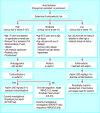Recent developments in atrial fibrillation
- PMID: 15677659
- PMCID: PMC546076
- DOI: 10.1136/bmj.330.7485.238
Recent developments in atrial fibrillation
Figures



Similar articles
-
[Guidelines for the management of patients with atrial fibrillation. Executive summary].Rev Esp Cardiol. 2006 Dec;59(12):1329. Rev Esp Cardiol. 2006. PMID: 17194429 Spanish. No abstract available.
-
Responding to atrial fibrillation.Nursing. 2007 Apr;37(4):36-41; quiz 41-2. doi: 10.1097/01.NURSE.0000266037.44966.67. Nursing. 2007. PMID: 17413363 No abstract available.
-
Electrical and pharmacologic cardioversion for atrial fibrillation.Cardiol Clin. 2009 Feb;27(1):95-107, ix. doi: 10.1016/j.ccl.2008.09.008. Cardiol Clin. 2009. PMID: 19111767 Review.
-
An overview of atrial fibrillation.Nurs Stand. 2012 Aug 29-Sep 4;26(52):47-56; quiz 58. doi: 10.7748/ns2012.08.26.52.47.c9254. Nurs Stand. 2012. PMID: 23061130
-
[Atrial fibrillation--treatment].Dtsch Med Wochenschr. 2001 Dec 21;126(51-52):1472-5. doi: 10.1055/s-2001-19207. Dtsch Med Wochenschr. 2001. PMID: 11753741 Review. German. No abstract available.
Cited by
-
Value of trans-oesophageal echocardiography as a method of encouraging patients with chronic atrial fibrillation to use anticoagulation therapy.Cardiovasc J Afr. 2010 Jul-Aug;21(4):192-4. doi: 10.5830/cvja-2010-017. Cardiovasc J Afr. 2010. PMID: 20838716 Free PMC article.
-
The Role of the Rho/ROCK Pathway in Ang II and TGF-β1-Induced Atrial Remodeling.PLoS One. 2016 Sep 9;11(9):e0161625. doi: 10.1371/journal.pone.0161625. eCollection 2016. PLoS One. 2016. PMID: 27611832 Free PMC article.
-
Use of intravenous magnesium to treat acute onset atrial fibrillation: a meta-analysis.Heart. 2007 Nov;93(11):1433-40. doi: 10.1136/hrt.2006.111492. Epub 2007 Apr 20. Heart. 2007. PMID: 17449500 Free PMC article. Review.
-
One hundred years of atrial fibrillation.Br J Clin Pharmacol. 2005 Oct;60(4):345-6. doi: 10.1111/j.1365-2125.2005.02501.x. Br J Clin Pharmacol. 2005. PMID: 16187965 Free PMC article. No abstract available.
-
Benefits and risks of long-term amiodarone therapy for persistent atrial fibrillation: a meta-analysis.Mayo Clin Proc. 2009 Mar;84(3):234-42. doi: 10.4065/84.3.234. Mayo Clin Proc. 2009. PMID: 19252110 Free PMC article.
References
-
- Feinberg WM, Blackshear JL, Laupacis A, Kronmal R, Hart RG. Prevalence, age distribution, and gender of patients with atrial fibrillation: analysis and implications. Arch Intern Med 1995;155: 469-73. - PubMed
-
- Ruigomez A, Johansson S, Wallander MA, Rodriguez LA. Incidence of chronic atrial fibrillation in general practice and its treatment pattern. J Clin Epidemiol 2002;55: 358-63. - PubMed
-
- Go AS, Hylek EM, Phillips KA, Chang Y, Henault LE, Selby JV, et al. Prevalence of diagnosed atrial fibrillation in adults: national implications for rhythm management and stroke prevention: the anticoagulation and risk factors in atrial fibrillation (ATRIA) study. JAMA 2001;285: 2370-5. - PubMed
-
- Kannel WB, Abbott RD, Savage DD, McNamara PM. Epidemiologic features of chronic atrial fibrillation: the Framingham study. N Engl J Med 1982;306: 1018-22. - PubMed
-
- Benjamin EJ, Levy D, Vaziri SM, D'Agostino RB, Belanger AJ, Wolf PA. Independent risk factors for atrial fibrillation in a population-based cohort: the Framingham heart study. JAMA 1994;271: 840-4. - PubMed
Publication types
MeSH terms
Substances
LinkOut - more resources
Full Text Sources
Other Literature Sources
Medical
